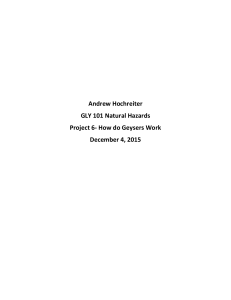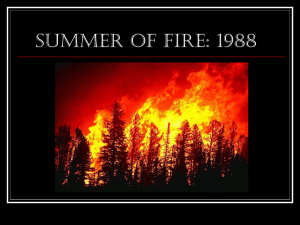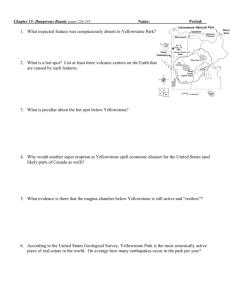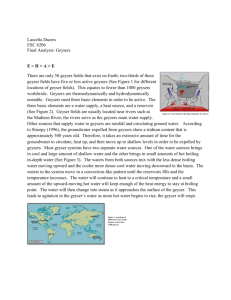Colby Tucker and Emily Quinton Geology 112 Term Paper Geysers
advertisement
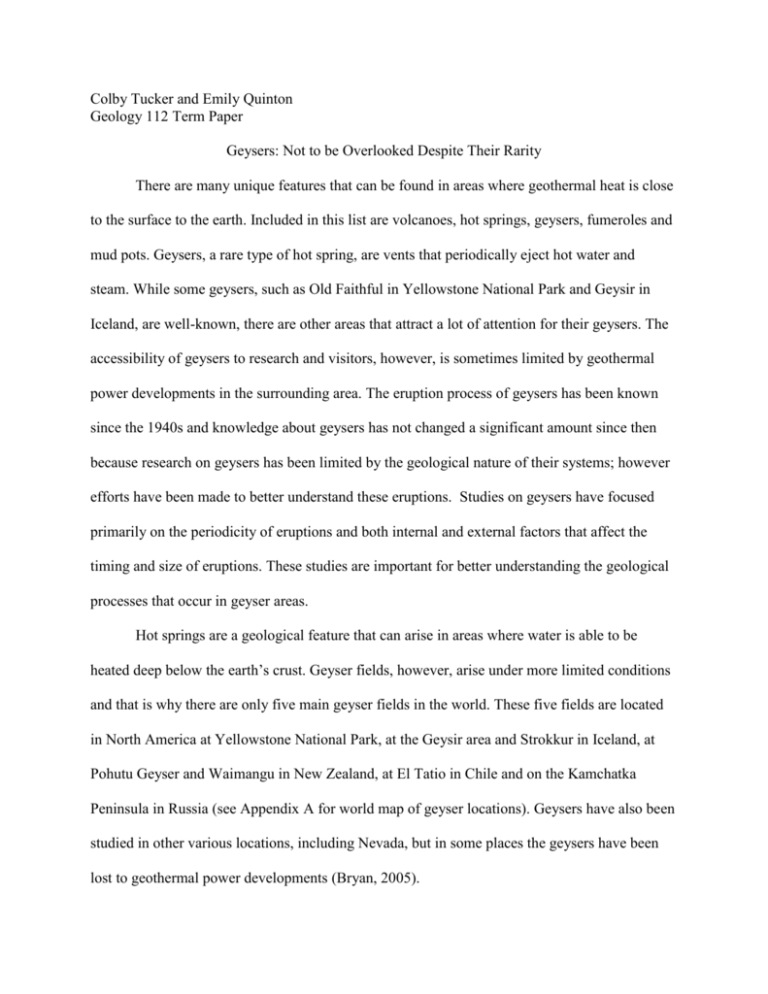
Colby Tucker and Emily Quinton Geology 112 Term Paper Geysers: Not to be Overlooked Despite Their Rarity There are many unique features that can be found in areas where geothermal heat is close to the surface to the earth. Included in this list are volcanoes, hot springs, geysers, fumeroles and mud pots. Geysers, a rare type of hot spring, are vents that periodically eject hot water and steam. While some geysers, such as Old Faithful in Yellowstone National Park and Geysir in Iceland, are well-known, there are other areas that attract a lot of attention for their geysers. The accessibility of geysers to research and visitors, however, is sometimes limited by geothermal power developments in the surrounding area. The eruption process of geysers has been known since the 1940s and knowledge about geysers has not changed a significant amount since then because research on geysers has been limited by the geological nature of their systems; however efforts have been made to better understand these eruptions. Studies on geysers have focused primarily on the periodicity of eruptions and both internal and external factors that affect the timing and size of eruptions. These studies are important for better understanding the geological processes that occur in geyser areas. Hot springs are a geological feature that can arise in areas where water is able to be heated deep below the earth’s crust. Geyser fields, however, arise under more limited conditions and that is why there are only five main geyser fields in the world. These five fields are located in North America at Yellowstone National Park, at the Geysir area and Strokkur in Iceland, at Pohutu Geyser and Waimangu in New Zealand, at El Tatio in Chile and on the Kamchatka Peninsula in Russia (see Appendix A for world map of geyser locations). Geysers have also been studied in other various locations, including Nevada, but in some places the geysers have been lost to geothermal power developments (Bryan, 2005). About half of the geysers on Earth are located in Yellowstone. Approximately 500 geysers are located here and the protection provided by the national park service has helped to preserve this number and foster long term research opportunities (Cross, 1996). Old Faithful is Yellowstone’s most famous geyser, erupting approximately 10,000 – 12,000 gallons of water every 30 – 90 minutes (“Geothermal Energy and Geysers, EIA). New Zealand has approximately 70 active geysers, with Waimangu being perhaps its most famous one, as it was once the world’s largest (Cody, 1999). Iceland’s most famous geyser – Geysir, is the namesake of these rare forms of hot springs. The name comes from the Icelandic word “to gush” (Reynolds, 1941). Geysers are located in one of two areas. They are either located at plate boundaries, where the earth’s plates are either converging or diverging, or they are located on a geological hot spot. Yellowstone and Iceland are both located on hot spots. Unlike plate boundaries that are moving relative to one another, hot spots are fixed locations beneath the lithosphere where a plume of magma is close to the surface creating features like volcanic arcs (Marshak, 2008). Despite the differences between the two types of locations where geysers are found, the important aspect is that heat is available close the surface of the earth. It is no coincidence that geysers are a rarity on Earth—they require quite a bit of luck in their formation. Not only are there two very specific locations where they can form, but also they require proximity to a heat source, certain rock chemistry, water volume (and holding capacity), and specific plumbing. The heat source is the basis of the energy within the geyser system and the rock chemistry and plumbing is what contains the energy inside the system. The rocks within a geyser are dominated by geyserite, a special kind of rock made of silicon dioxide that covers the pores in the rocks and makes the system pressure tight. The plumbing of geysers is a network of fractures and channels allowing water to flow freely like in the plumbing system of a house (see Appendix B). The water can flow uninhibited from the source to the surface, but it is thought to take at least 1,100 years (Bryan, 2005). An eruption occurs by water seeping through the ground until it meets rocks heated by magma. Water pools and begins to rise through the plumbing. There are likely to be several sitting pools of boiling water throughout the plumbing that help feed the system and the eruption, especially for the recharge of the geyser. The heat then rises by convection through the plumbing of the geyser. Since the water on the surface is cooler and therefore denser, it presses down on the system. Some of the hot water turns to steam, causing an initial overflow or bulge of water at the top. The bulging reduces some of the pressure and allows the convection current to continue to rise. The bulge will fall and as the heated water nears the surface the convection currents begin to fail as the plumbing narrows, though the process of the surface water bulging and falling may occur several times. Throughout this process, the water becomes superheated like in a pressure cooker with no release valve (Bryan, 2005). As the heat and pressure increases, the water bulges up one final time and finally erupts. The recharge of the geyser begins immediately as water beneath the eruption fills the vacant area with the water returning back down. Some of the water, however, has been ejected so far that it will likely not return to the surface of the geyser, but rather percolate down through the soil and porous rocks until it is fed back into the system via the geyser’s plumbing and ground water interactions. It is this water that Bryan (2005) says will take another 1,100 years to reach the surface. Yet, for all the natural circumstances people have found geysers to require for their existence, many geysers are very unpredictable in their eruption intervals. This mystery has been the focus of many people’s research, as geysers display a curiously chaotic nature (Nichol et al, 1994). Stuart Rojstaczer and S.E. Ingebristen are today’s authorities on geyser activity and behavior. In their most recent co-authored paper (2003), the authors collected “high-quality geyser-frequency time series” from six geysers in Yellowstone National Park. Using this data in conjunction with meteorological data and the time series from the other geysers, the authors were able to suggest and rule out factors that may be related to the frequency of geyser eruptions (Rojstaczer and Ingebristen, 2003). Firstly, elastic deformation, which is a rock’s response to stress in the form of bending, was once thought to be a major factor in the eruptive timing. This theory, which stated that the rock’s compressibility within the plumbing was at least partially responsible for the variable timing of eruptions, is now thought to be less significant (Rojstaczer and Ingebristen, 2003). The authors proposed that the long distance interconnections (up to 1.5 km) between geysers are a stronger influence in the eruptive timing than rock compressibility. Secondly, as suggested by some, but found to be insignificant, are Earth-tide influences and atmospheric pressure changes on a daily basis (Rojstaczer and Ingebristen, 2003). Over a longer period of time, on the order of weeks, atmospheric pressure changes over 5 mBars was correlated to the eruptive timings of four of the six geysers studied. The other two geysers, while not directly affected by the atmospheric changes were influenced by the eruptions of at least one of the other affected geysers, making every geyser eruption at least indirectly related to atmospheric pressure changes above 5 mBars (Rojstaczer and Ingebristen, 2003). The difficulty in being certain with the relationship of a single variable to the timing of eruptions must not be overlooked. Geyser systems are complex and dynamic (especially on the geologic timescale). They cannot be reduced to a single controlling factor or even several static factors. Research on geysers has been fairly limited in scope, which may be related to the difficulty in studying geysers. The general definition of a geyser and information on how it erupts has not evolved much and a quick overview of the type of research that has been done on geysers does not show that much progress either. After learning about geysers, however, it is clear to see the importance of these systems and why research on what affects geysers is important. By definition, geysers are rare. This aspect makes them an important geological feature because it makes the areas in which they are located special (“Geothermal Energy and Geysers, EIA). Research on whether geysers respond to certain internal and external forces and variables could be helpful once these responses are better understood. Knowledge about what affects a geyser could be helpful in examining the types of forces that occur in the volcanic areas they are situated in. The rarity of geysers also means that efforts should be made not to destroy them. While natural processes that lead to the inactivity of a geyser are unavoidable, human influences can be changed. Geothermal power developments changing the water table have led to the extinction of geysers. Littering by visitors can block the geyser conduit (Bryan, 2005). While littering is an issue that can easily be stopped, geyser presence may not always be considered in geothermal power developments. Scientific studies and textbooks reveal surprisingly little information about geysers beyond their definition and eruption process. While this reflects the difficulty in studying these systems, it also reaffirms the importance of continuing to study geysers. As a very rare geological feature found on land, geysers can reveal information about certain natural processes. Further research will focus more on the factors discussed that affect the periodicity of eruptions and will hopefully lead to increased understanding of the places where geysers are found. Considering that 70% of the planet is covered with water, there may realistically be geysers in the oceans that are still too difficult to find. Bryan, Scott T. Geysers: What They Are and How They Work, 2nd ed, Mountain Press Publishing Company, Missoula, MT, 2005. Cody, A., Present-day geysers of New Zealand, Newsletter – Geological Society of New Zealand, 118:9-13, 1999. Cross, Jeff. Geyser Studies in Yellowstone National Park, Geological Society of America, 28(7):ABSTRACT #144, 1996. “Geothermal Energy and Geysers”. Sponsored by the Energy Information Association. <http://www.eia.doe.gov/cneaf/solar.renewables/renewable.energy.annual/appc.html> last modified 23 January 2003, visited 7 October 2008. Manga, M., and Brodsky, E., Seismic triggering of eruptions in the far field: volcanoes and geysers, Annual Review of Earth and Planetary Sciences, 34:263-291, 2006. Marshak, Steven. Earth: Portrait of a Planet, 3rd ed., Norton & Company, New York. pg. 104; 674-675, 2008. Nichol, M. J, Wheatcraft, S. W., Tyler, S. W., Berkowitz, B., Is Old Faithful a strange attractor? Journal of Geophysical Research, 99(B3), 4495-4503, 1994. Reynolds, S. H., Fumeroles, hot springs and geysers, Bristol Naturalists’ Society, 9(2):251-263, 1941. Appendix A: The map of geyser locations and geyser fields worldwide (Bryan, 2005). Appendix B: The plumbing system of a geyser (Bryan, 2005).
